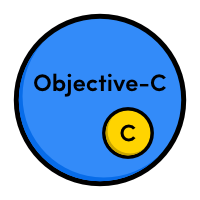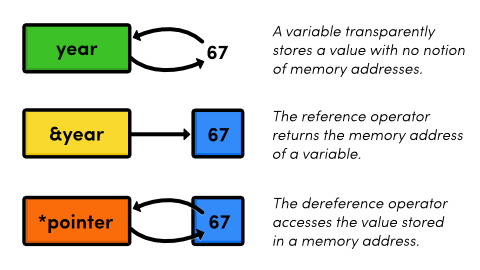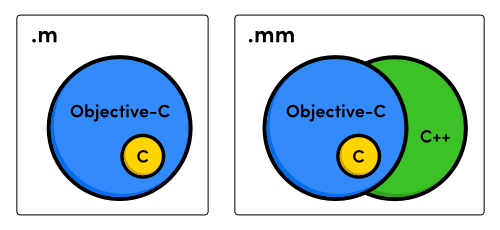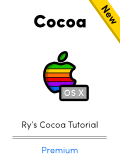You’re reading Ry’s Objective-C Tutorial |
C Basics
Objective-C is a strict superset of C, which means that it’s possible to seamlessly combine both languages in the same source file. In fact, Objective-C relies on C for most of its core language constructs, so it’s important to have at least a basic foundation in C before tackling the higher-level aspects of the language.

This module provides a concise overview the C programming language. We’ll talk about comments, variables, mathematical operators, control flow, simple data structures, and the integral role of pointers in Objective-C programs. This will give us the necessary background to discuss Objective-C’s object-oriented features.
Comments
There are two ways to include commentary text in a C program. Inline
comments begin with a double slash and terminate at the end of the
current line. Block comments can span multiple lines, but they
must be enclosed in /* and */ characters. For
example:
// This is an inline comment/* This is a block comment.It can span multiple lines. */
Since comments are completely ignored by the compiler, they let you include extra information alongside your code. This can be useful for explaining confusing snippets; however, Objective-C is designed to be very self-documenting, so you shouldn’t really need to include a lot comments in your iOS or OS X applications.
Variables
Variables are containers that can store different values.
In C, variables are statically typed, which means that you must explicitly
state what kind of value they will hold. To declare a
variable, you use the <type> <name> syntax, and
to assign a value to it you use the = operator. If you need to
interpret a variable as a different type, you can cast it by
prefixing it with the new type in parentheses.
All of this is demonstrated in the following example. It declares a variable
called odometer that stores a value of type double.
The (int)odometer statement casts the value stored in
odometer to an integer. If you paste this code into your
main.m file in Xcode and run the program, you should see the
NSLog() messages displayed in your Output panel.
// main.m#import<Foundation/Foundation.h>intmain(intargc,constchar*argv[]){@autoreleasepool{doubleodometer=9200.8;intodometerAsInteger=(int)odometer;NSLog(@"You've driven %.1f miles",odometer);// 9200.8NSLog(@"You've driven %d miles",odometerAsInteger);// 9200}return0;}
Along with double and int, C defines a plethora of
primitive data types. A comprehensive list can be found in the Primitives module, as well as an
explanation of the %.1f and %d format specifiers used
above.
Constants
The const variable modifier can be used to tell the compiler
that a variable is never allowed to change. For example, defining a constant
called pi and then trying to alter it will result in a compiler
error:
doubleconstpi=3.14159;pi=42001.0;// Compiler error
This is often used in function parameters to inform the caller that they can safely assume whatever value they pass will not be altered by the function.
Arithmetic
The familiar +, -, *, /
symbols are used for basic arithmetic operations, and the modulo operator
(%) can be used to return the remainder of an integer division.
These are all demonstrated below.
NSLog(@"6 + 2 = %d",6+2);// 8NSLog(@"6 - 2 = %d",6-2);// 4NSLog(@"6 * 2 = %d",6*2);// 12NSLog(@"6 / 2 = %d",6/2);// 3NSLog(@"6 %% 2 = %d",6%2);// 0
Special care must be taken when performing operations that involve both floating-point and integer types. Please see Integer Division for details.
You’ll also frequently encounter the increment (++) and
decrement (--) operators when working with loops. These are
convenience operators for adding or subtracting 1 from a variable.
For example:
inti=0;NSLog(@"%d",i);// 0i++;NSLog(@"%d",i);// 1i++;NSLog(@"%d",i);// 2
Conditionals
C provides the standard if statement found in most programming
languages. Its syntax, along with a table describing the most common
relational/logical operators, is shown below.
intmodelYear=1990;if(modelYear<1967){NSLog(@"That car is an antique!!!");}elseif(modelYear<=1991){NSLog(@"That car is a classic!");}elseif(modelYear==2013){NSLog(@"That's a brand new car!");}else{NSLog(@"There's nothing special about that car.");}
| Operator | Description |
|---|---|
a == b |
Equal to |
a != b |
Not equal to |
a > b |
Greater than |
a >= b |
Greater than or equal to |
a < b |
Less than |
a <= b |
Less than or equal to |
!a |
Logical negation |
a && b |
Logical and |
a || b |
Logical or |
C also includes a switch statement, however it only works with
integral types—not floating-point numbers, pointers, or Objective-C
objects. This makes it rather inflexible when compared to the if
conditionals discussed above.
// Switch statements (only work with integral types)switch(modelYear){case1987:NSLog(@"Your car is from 1987.");break;case1988:NSLog(@"Your car is from 1988.");break;case1989:case1990:NSLog(@"Your car is from 1989 or 1990.");break;default:NSLog(@"I have no idea when your car was made.");break;}
Loops
The while and for loops can be used for iterating
over values, and the related break and continue
keywords let you exit a loop prematurely or skip an iteration,
respectively.
intmodelYear=1990;// While loopsinti=0;while(i<5){if(i==3){NSLog(@"Aborting the while-loop");break;}NSLog(@"Current year: %d",modelYear+i);i++;}// For loopsfor(inti=0;i<5;i++){if(i==3){NSLog(@"Skipping a for-loop iteration");continue;}NSLog(@"Current year: %d",modelYear+i);}
While it’s technically not a part of the C programming language, this
is an appropriate time to introduce the for-in loop. This is
referred to as the fast-enumeration syntax because it’s
a more efficient way to iterate over Objective-C collections like NSSet and NSArray than the traditional
for and while loops.
// For-in loops ("Fast-enumeration," specific to Objective-C)NSArray*models=@[@"Ford",@"Honda",@"Nissan",@"Porsche"];for(idmodelinmodels){NSLog(@"%@",model);}
Macros
Macros are a low-level way to define symbolic constants and space-saving
abbreviations. The #define directive maps a macro name to an
expansion, which is an arbitrary sequence of characters. Before the compiler
tries to parse the code, the preprocessor replaces all occurrences of the macro
name with its expansion. In other words, it’s a straightforward
search-and-replace:
// main.m#import<Foundation/Foundation.h>#definePI 3.14159#defineRAD_TO_DEG(radians) (radians * (180.0 / PI))intmain(intargc,constchar*argv[]){@autoreleasepool{doubleangle=PI/2;// 1.570795NSLog(@"%f",RAD_TO_DEG(angle));// 90.0}return0;}
This code snippet demonstrates the two types of C macros: object-like macros
(PI) and function-like macros (RAD_TO_DEG(radians)).
The only difference is that the latter is smart enough to accept arguments and
alter their expansions accordingly.
Typedef
The typedef keyword lets you create new data types or redefine
existing ones. After typedef’ing an unsigned char in the
following example, we can use ColorComponent just like we would
use char, int, double, or any other
built-in type:
// main.m#import<Foundation/Foundation.h>typedefunsignedcharColorComponent;intmain(intargc,constchar*argv[]){@autoreleasepool{ColorComponentred=255;ColorComponentgreen=160;ColorComponentblue=0;NSLog(@"Your paint job is (R: %hhu, G: %hhu, B: %hhu)",red,green,blue);}return0;}
While this adds some meaningful semantics to our code, typedef
is more commonly used to turn struct’s and
enum’s into convenient data types. This is demonstrated in
the next two sections.
Structs
A struct is like a simple, primitive C object. It lets you
aggregate several variables into a more complex data structure, but
doesn’t provide any OOP features (e.g., methods). For example, the
following snippet uses a struct to group the components of an RGB
color. Also notice how we typedef the struct so that
we can access it via a meaningful name.
// main.m#import<Foundation/Foundation.h>typedefstruct{unsignedcharred;unsignedchargreen;unsignedcharblue;}Color;intmain(intargc,constchar*argv[]){@autoreleasepool{ColorcarColor={255,160,0};NSLog(@"Your paint job is (R: %hhu, G: %hhu, B: %hhu)",carColor.red,carColor.green,carColor.blue);}return0;}
To populate the new carColor structure, we used the {255,
160, 0} initializer syntax. This assigns values in the
same order as they were declared in the struct. And, as you can
see, each of its fields can be accessed via dot-syntax.
Enums
The enum keyword is used to create an enumerated
type, which is a collection of related constants. Like
structs, it’s often convenient to typedef
enumerated types with a descriptive name:
// main.m#import<Foundation/Foundation.h>typedefenum{FORD,HONDA,NISSAN,PORSCHE}CarModel;intmain(intargc,constchar*argv[]){@autoreleasepool{CarModelmyCar=NISSAN;switch(myCar){caseFORD:casePORSCHE:NSLog(@"You like Western cars?");break;caseHONDA:caseNISSAN:NSLog(@"You like Japanese cars?");break;default:break;}}return0;}
Since the myCar variable was declared with the
CarModel type, it can only store the four
enumerators defined by the enumerated type: FORD,
HONDA, NISSAN, and PORSCHE. Defining
these in an enumerated type is more reliable than representing the various
CarModel’s with arbitrary strings, as it’s impervious
to spelling errors (the compiler will let you know when you mistype one of the
above enumerators).
The Cocoa frameworks rely on enums for many of their constants. For
example, NSSearchPathDirectory
defines the standard directory paths used by OS X. The Persistent Data
chapter of Ry’s Cocoa
Tutorial provides many examples of how this works.
Primitive Arrays
Since Objective-C is a superset of C, it has access to the primitive arrays
found in C. Generally, the higher-level NSArray and NSMutableArray
classes provided by the Foundation Framework are much more convenient than C
arrays; however, primitive arrays can still prove useful for performance
intensive environments. Their syntax is as follows:
intyears[4]={1968,1970,1989,1999};years[0]=1967;for(inti=0;i<4;i++){NSLog(@"The year at index %d is: %d",i,years[i]);}
The int years[4] statement allocates a contiguous block of
memory large enough to store 4 int values. We then populate the
array using the {1968, ...} initializer syntax and access its
elements by passing offsets between square brackets (e.g.,
years[i]).
Pointers
A pointer is a direct reference to a memory address. Whereas a variable acts as a transparent container for a value, pointers remove a layer of abstraction and let you see how that value is stored. This requires two new tools:
- The reference operator (
&) returns the memory address of a normal variable. This is how you create pointers. - The dereference operator (
*) returns the contents of a pointer’s memory address.
The following example demonstrates how to declare, create, and dereference
pointers. Note that defining a pointer looks exactly like defining a normal
variable, except it’s prepended with an asterisk (*).
intyear=1967;// Define a normal variableint*pointer;// Declare a pointer that points to an intpointer=&year;// Find the memory address of the variableNSLog(@"%d",*pointer);// Dereference the address to get its value*pointer=1990;// Assign a new value to the memory addressNSLog(@"%d",year);// Access the value via the variable
The behavior of these pointer operators can be visualized as follows:

In the above example, pointers are merely an unnecessary abstraction for normal variables. Their real utility comes from the fact that you can move a pointer to the surrounding memory addresses. This is particularly useful for navigating arrays, which are just contiguous blocks of memory. For example, the code below uses a pointer to iterate through the elements of an array.
charmodel[5]={'H','o','n','d','a'};char*modelPointer=&model[0];for(inti=0;i<5;i++){NSLog(@"Value at memory address %p is %c",modelPointer,*modelPointer);modelPointer++;}NSLog(@"The first letter is %c",*(modelPointer-5));
When used with a pointer, the ++ operator moves the it to the
next memory address, which we can display through NSLog() with the
%p specifier. Likewise, the -- operator can be used
to decrement the pointer to the previous address. And, as shown in the last
line, you can access an arbitrary address relative to the current pointer
position.
The Null Pointer
The null pointer is a special kind of pointer that doesn’t point to
anything. There is only one null pointer in C, and it is referenced through the
NULL macro. This is useful for indicating empty
variables—something that is not possible with a normal data type. For
instance, the following snippet shows how pointer can be
“emptied” using the null pointer.
intyear=1967;int*pointer=&year;NSLog(@"%d",*pointer);// Do something with the valuepointer=NULL;// Then invalidate it
The only way to represent an empty variable using year on its
own is to set it to 0. Of course, the problem is that
0 is still a perfectly valid value—it’s not the
absence of a value.
Void Pointers
A void pointer is a generic type that can point to anything.
It’s essentially a reference to an arbitrary memory address. Accordingly,
more information is required to interpret the contents of a void pointer. The
easiest way to do this is to simply cast it to a non-void pointer. For example,
the (int *) statement in the following code interprets the
contents of the void pointer as an int value.
intyear=1967;void*genericPointer=&year;int*intPointer=(int*)genericPointer;NSLog(@"%d",*intPointer);
The generic nature of void pointers affords a lot flexibility. For example,
the NSString
class defines the following method for converting a C array into an Objective-C
string object:
-(id)initWithBytes:(constvoid*)byteslength:(NSUInteger)lengthencoding:(NSStringEncoding)encoding
The bytes argument points to the first memory address of any
kind of C array, the length argument defines how many bytes to
read, and encoding determines how those bytes should be
interpreted. Using a void pointer like this makes it possible to work with
any type of character array. The alternative would be to define
dedicated methods for single-byte, UTF-8, and UTF-16 characters, etc.
Pointers in Objective-C
This is all good background knowledge, but for your everyday Objective-C
development, you probably won’t need to use most of it. The only thing
that you really have to understand is that all Objective-C objects are
referenced as pointers. For instance, an NSString object must be
stored as a pointer, not a normal variable:
NSString*model=@"Honda";
When it comes to null pointers, there is a slight difference between C and
Objective-C. Whereas C uses NULL, Objective-C defines its own
macro, nil, as its null object. A good rule of thumb is to use
nil for variables that hold Objective-C objects and
NULL when working with C pointers.
NSString*anObject;// An Objective-C objectanObject=NULL;// This will workanObject=nil;// But this is preferredint*aPointer;// A plain old C pointeraPointer=nil;// Don't do thisaPointer=NULL;// Do this instead
Outside of variable declarations, the entire Objective-C syntax is designed to work with pointers. So, after defining an object pointer, you can basically forget about the fact that it’s a pointer and interact with it as if it were a normal variable. This will be made abundantly clear from the examples throughout the rest of this tutorial.
Summary
This module introduced the fundamental aspects of the C programming language. While you’re not expected to be a C expert just yet, we hope that you’re feeling relatively comfortable with variables, conditionals, loops, structs, enums, and pointers. These tools form the foundation of any Objective-C program.
Objective-C relies on C for these basic constructs, but it also
gives you the option of inserting C++ code directly into your source
files. To tell the compiler to interpret your source code as either C, C++, or
Objective-C, all you have to do is change the file extension to
.mm.

.m and
.mm extensionsThis unique language feature opens the door to the entire C/C++ ecosystem, which is a huge boon to Objective-C developers. For example, if you’re building an iOS game and find yourself in need of a physics engine, you can leverage the well-known Box2D library (written in C++) with virtually no additional work.
The next module will complete our discussion of C with a brief look at functions. After that, we’ll be more than ready to start working with Objective-C classes, methods, protocols, and the rest of its object-oriented goodness.
 |
Be sure to check out Ry’s Cocoa Tutorial. This brand new guide is a complete walkthrough of Mac App development, and it leverages all of the Objective-C skills that we just discussed. Learn more › |
Mailing List
Sign up for my low-volume mailing list to find out when new content is released. Next up is a comprehensive Swift tutorial planned for late January.
You’ll only receive emails when new tutorials are released, and your contact information will never be shared with third parties. Click here to unsubscribe.